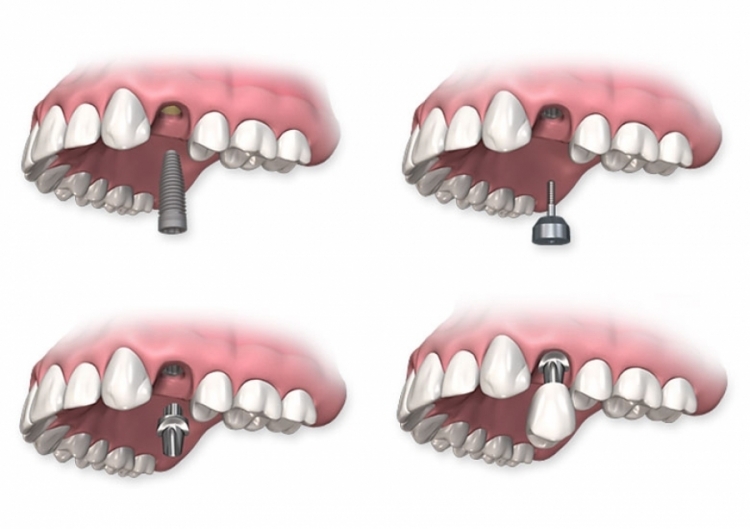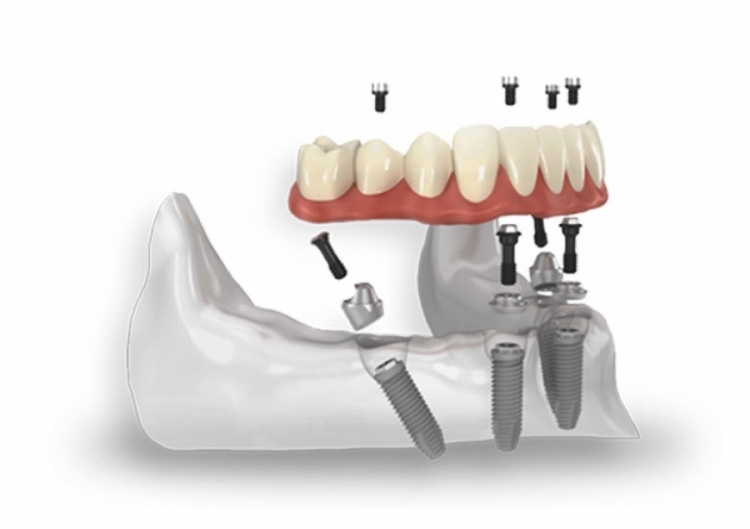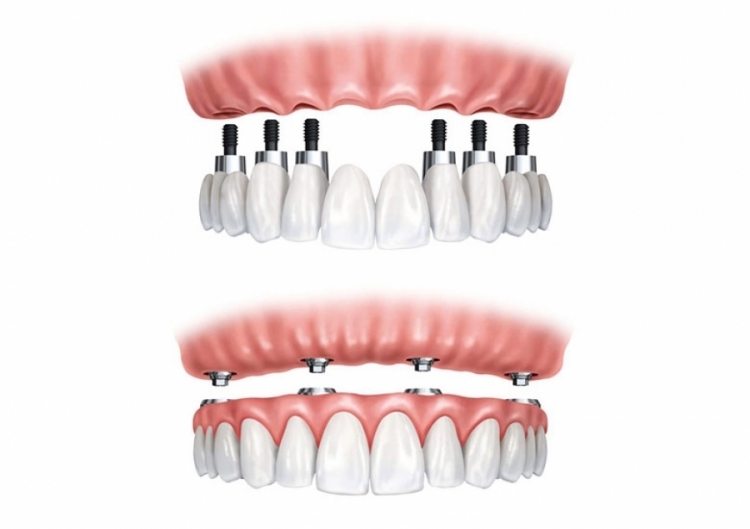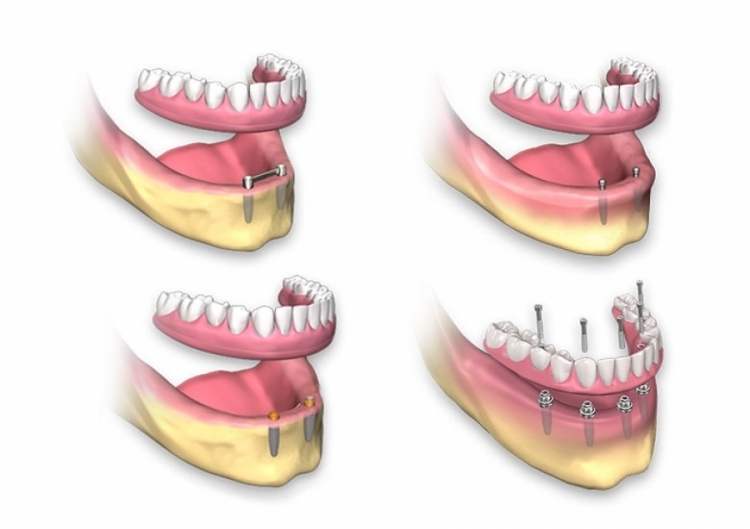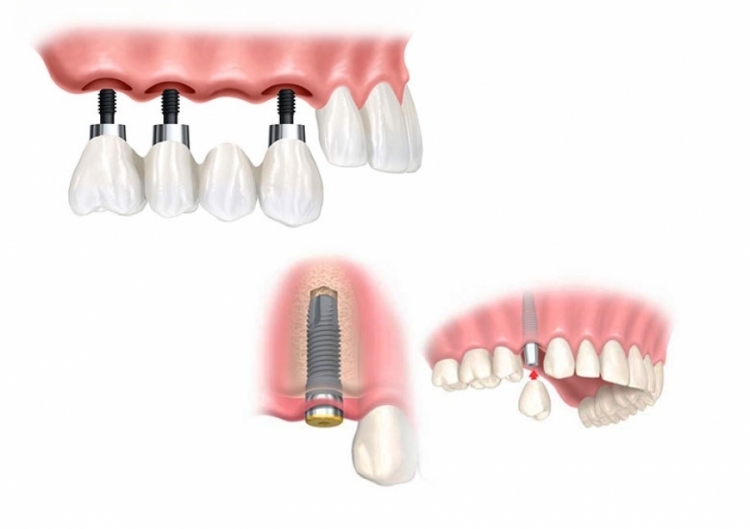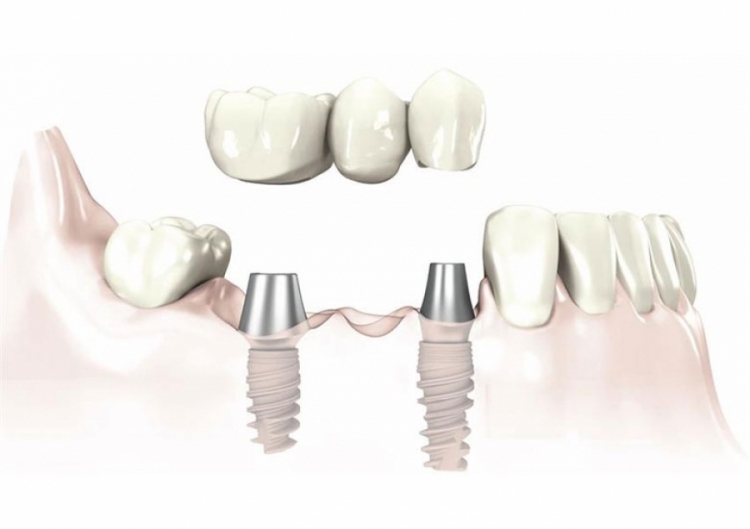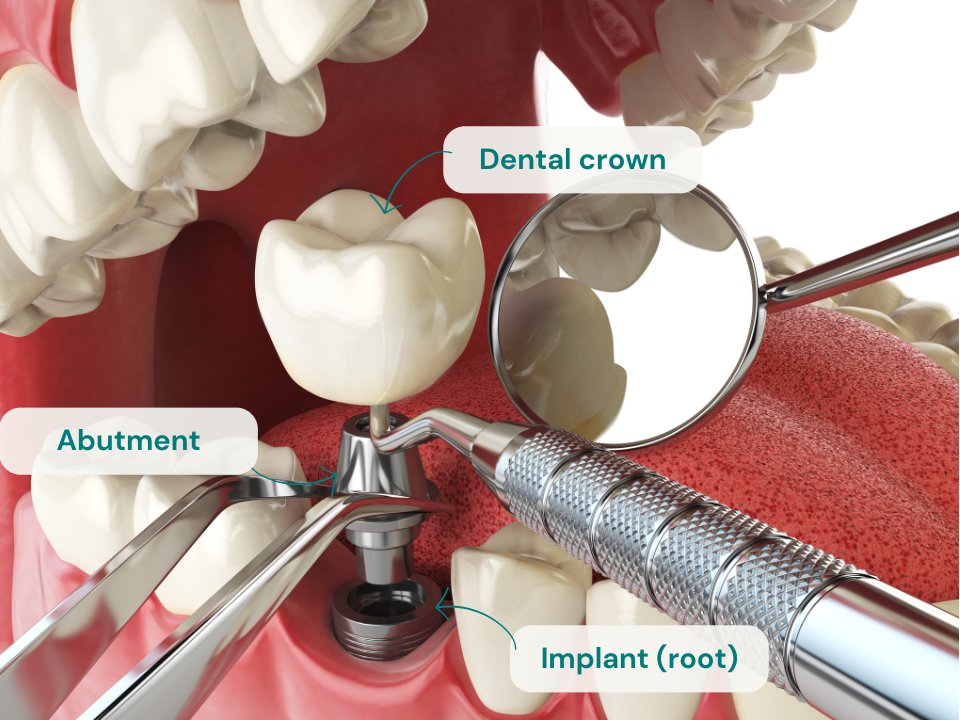Are you missing one or multiple teeth?
Dental implants
Dental implants are sophisticated and durable solutions designed to replace missing teeth, offering both aesthetic and functional benefits. These implants serve as artificial tooth roots, providing a stable foundation for prosthetic teeth such as crowns, bridges, or dentures

Options and benefits
Dental implants are substitutes from titanium, a biocompatible material that is surgically implanted into the jawbone to serve as a substitution for natural roots, or as carriers of prosthetic restoration. It consists of a sequence in a jaw bone and part which extends out from it, which is applied to the crown, bridge or removable dentures allowing safe and long fixation.
Aesthetic Appeal
Dental implants look and feel like natural teeth, restoring a confident and natural smile.
Improved Function
Longevity
Options
Implant dentistry can restore lost confidence, ensure proper quality and nutrition.
Replacement of individual tooth
Unlike other forms of compensation of individual teeth, the implants will be next to the tooth further compensate and root of the tooth, which also plays an important role.
Because of that Installing dental implants is the best solution.
All on 4 ™ – all on four dental implants method
All-on-4TM is a method of making and installing dentures for edentulous upper and lower jaw on only 4 implants.
This method is a good choice for people who want a fixed prosthesis, and don’t have a sufficient amount of bone in the back of the jaw, because of long-term loss of teeth due to the reduced amount of bone.
The patient receives a fixed temporary teeth within 24 hours. READ MORE
All on 6 ™ – all on six dental implants method
This technique is often employed when a patient is missing all or most of their teeth in a dental arch and desires a fixed and stable solution for tooth replacement.
This approach provides a comprehensive and stable solution for restoring an entire dental arch.
Prostheses on implants
Semi fixed prosthetics
Prostheses on implants are dentures that are attached to the dental implants. Dental implants are implanted in the jaw to build upon them special anchor points that can later run dentures.
In the upper jaw for making dentures on implants must be installed a minimum four implants while in the bottom minimum two implants.
Semi fixed prosthetics have the option of extracting, it’s easier to be repaired and professionally cleaned.
Bridges and crowns on implants at the screw
Prosthetic superstructures that are fixed by screws are demanding for technical production and therefore more expensive.
When crowns are attached to the nut, screw covers with restorative natural color of teeth (composite).
Upgrading dentures
Prosthetics on multiple implants
Implant-supported dentures are a popular option for those who are missing a full arch of teeth (either upper or lower).
Multiple dental implants act as anchors for a custom-made denture, providing improved stability and preventing issues such as denture slippage or discomfort.
2, 3, 4 or more implants, Acrylic, Perfectly stable, Possible to remove individualy and clean, Retention bar on implants (implant bar)
Procedure
What is dental implant?
A dental implant is an artificial tooth root, made of titanium or zirconium ceramic. It represents a base for your new artificial tooth.
On this artificial root (implant) we install an artificial tooth crown. The end result is full artificial tooth that contains:
Dental implant
Extension or abutment
Extension or abutment, the part that connects the dental implant to the crown
Dental crown
Dental crown, made of metal-ceramic or pure, metal-free ceramic
Dental implant procedure
The surgical phase involves the placement of the dental implant into the jawbone.
Before the surgery, local anesthesia is administered to ensure you are comfortable and pain-free during the procedure. An incision is made in the gum to expose the jawbone, and a small hole is drilled into the bone to accommodate the implant. The implant, usually a titanium screw, is then carefully placed into the prepared site. The incision is closed with stitches, and a temporary restoration may be placed.
Inital Examination and 3Shape scan
Implantation - Surgery
The implant is embedded in the first visit , protect it with the cover bolt and cover it with the mucus.
Healing process
This integration provides a stable foundation for prosthetic restoration.
Dental crown placement
Our results
How we make your dental implants
Step into a world where cutting-edge technology meets the skilled artistry of our dental professionals. Our clinic is a haven for those seeking not just routine dental care but a transformational experience. From routine check-ups to advanced cosmetic procedures, we specialize in a wide array of dental services, all designed to bring out the best in your smile.
Frequently asked questions
FAQ dental implants
Are dental implants suitable for everyone?
There is no age limit for embedding implants.
They are not recommended in the case of various diseases such as advanced osteoporosis, uncontrolled diabetes, and some serious chronic heart, kidney, psychosis, etc..
In case of insufficient bone mass rebuild bone mass before implant insertion.
What is the process of implant placement?
The procedure is most often performed in two steps .
The implant is embedded in the first visit, protect it with the cover bolt and cover it with the mucus.
After a period of healing usually lasts for 3 to 6 months, or 6 to 9 months, when implant implants are performed with sinus lift surgery (upper jaw), the mucous membrane and implant are opened and implants are placed on the elements through which the implant position in his mouth is transmitted to a sophisticated model for a technician.
And pain?
What is duration of the surgery?
For patients it is most interesting that modern implantology is increasingly providing fast solutions, which means immediately after implantation, on the same day or in the next few days, depending on the size of the prosthetic work, the patient gets a fixed or mobile prosthetic replacement.
What about implants when bones are missing?
If the bone is not enough to integrate the implant, it is necessary to access augmentation of bone ie upgrading and creating bone by transplanting your own or using artificial bone. This surgical procedure is performed if there is no required width or height of the jawbone. An operation can be made in both jaws if there are minimal bases for the patient’s bone. Depending on the situation, implants sometimes are implanted at the same time as augmentation, while in the case of severe cases bone augmentation is first required and implants are to be implanted only after the necessary healing time.
What is osteointegration of dental implants (bruising)
Dental implants are artificial roots – titanium bolts. And how do they keep in the bones? Mechanically, like nails, bolts or dents or as our natural teeth?
Primary, mechanical stability
Immediately after implant placement and several weeks after dental implant placement, their bone stability is of a purely mechanical nature. The implants have threads, the implant lining is prepared depending on bone hardness so that the implants are embedded in a certain force.
Of course, after implantation of dental implants there is a reaction in the surrounding bone and the purity of the mechanical stability decreases two weeks after implantation.
But at about the same time with the loss of mechanical stability, biological stability is developing.
Secondary, biological stability
Due to the biocompatibility of titanium and the rough surface of dental implants, biological stability develops. The “rough” implant surface is an adjective behind which decades of intensive research and experimentation, with the aim of obtaining an implant surface that will optimally interact with the bone. Over the last few years, great progress has been made in perfecting the design and surface of the implant. The aim is to achieve the best possible urination of vital bone cells in the microstructure of dental implants. We talk about stem dental implants from bone, about orointegration.
Tertiary stability
Tertiary stability occurs after functional integration and loading of dental implants. Thus, after the implants have placed crowns, bridges or skeletal prostheses and implants exposed to tears.

